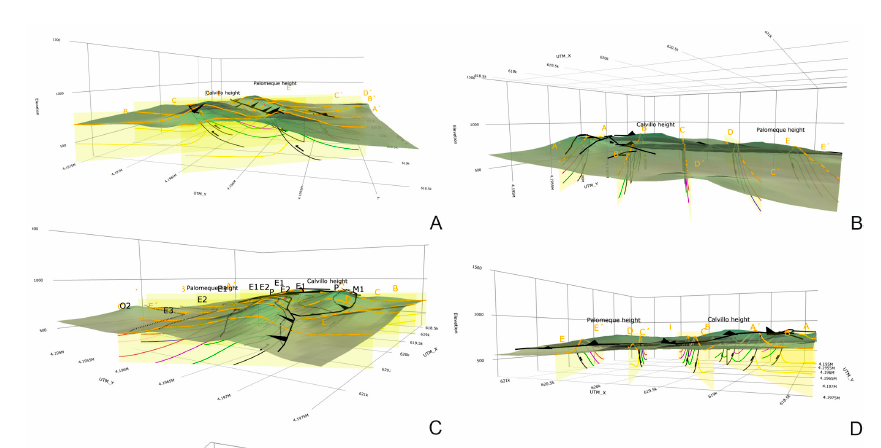Home » Posts tagged '3d geological map'
Tag Archives: 3d geological map
3D modeling of the stratigraphic and structural architecture of the Crotone basin (southern Italiy) using machie learning with Python
The 3D modeling and representation of geological data have experienced significant growth within last years, due to the use of new technologies derived from advancements in land representation methods. These technologies enable interactive, intuitive and clear geological visualizations. This paper shows how, by using the open-source Python software (operable with a simple internet browser) for machine learning (linear and KNN interpolations), together with Geographic Information Systems (GIS), it is possible to achieve interactive 3D visualizations of geological features in sedimentary basins. This study is performed in the onshore-offshore Crotone area (southern Italy) where a large amount of stratigraphic datasets are available from core perforation and seismic profiles due to the presence of a natural gas extraction field. Thanks to a database of 63 drilling lithologic records and 43 check points obtained from 9 interpreted seismic sections, several 3D HTML models were constructed defining three stratigraphic units (Pre-Messinian, Messinian, and Post-Messinian). An overlap of the Post-Messinian top surface and an erosional truncation of the Messinian top surface toward the N were observed, together with a rising of the Pre-Messinian top surface in the northwestern area. This stratigraphic architecture may indicate differential subsidence and/or uplifting due to syn-sedimentary fault kinematics in the whole studied area. The 3D models with the stratigraphic unit boundary surfaces obtained with KNN interpolation (showing stepped and abrupt edges) allowed the interpretation in terms of structural architecture and synsedimentary fault kinematics. Three main sets of faults were deduced: N–S; NNW-SSE, and ENE-WSW. A minorly represented E-W set was added to the main sets. These faults generated a horsts-grabens structure, and in many cases a determinate set of faults caused a progressive lowering or rising of some areas with an “en echelon” arrangement. According to previous works, these deduced sets of faults (most of them strike-slip faults) have a good agreement with the general structural architecture and defined faults in the area.

Cite as: Falsetta, E., Bullejos, M., Critelli, S. and Martín-Martín M. (2024). 3D modeling of the stratigraphic and structural architecture of the Crotone basin (southern Italy) using machine learning with Python. Marine and Petroleum Geology 164 (2024) 106825. https://doi.org/10.1016/j.marpetgeo.2024.106825
3D Visualization of geological structures using Python: the case study of the Palomeque sheets
The goal of this paper is the construction of computerized 3D visualization of geological structures. Several Python applications have been used to adapt the paper map-based geological classical information to numerical geological maps represented in HTML files. The models include a map with the stratigraphic and structural contacts and symbols, five serial vertical sections, and a geological block diagram, all with real topography. This block diagram made with 2D figures allows a 3D visualization. Palomeque area (Murcia region, southeastern Spain) has been used as a key-case. This area consists of a deformed Upper Cretaceous to Oligocene succession belonging to the Internal Zone Malaguide Complex. The main structure consists of two thrust-fold sheets forming an imbricate system, also affected by a set of strike-slip faults with a sinistral regime. The constructed maps show a good agreement with the published classical geological maps and cross-sections demonstrating the benefits of using these Python applications.

Cite as: Bullejos, M. and Martín-Martín, M. (2023): 3D Visualization of geological structures using Python: the case study of the Palomeque sheets (SE, Spain). Journal of Maps 19, NO. 1, 2282593 https://doi.org/10.1080/17445647.2023.2282593
A Python Application for Visualizing an Imbricate Thrust System: Palomeque Duplex (SE, Spain)
This paper introduces a Python application for visualizing an imbricate thrust system. The application uses the traditional geologic information to create an HTML geological map with real topography and a set of geological cross-sections with the essential structural and stratigraphic elements. On the basis of the high geological knowledge gained during the last three decades, the Palomeque sheets affecting the Cenozoic Malaguide succession in the Internal Betic Zone (SE Spain) were selected to show the application. In this area, a Malaguide Cretaceous to Lower Miocene succession is deformed as an imbricate thrust system, with two thrusts forming a duplex, affected later by a set of faults with a main strike-slip kinematic. The modeled elements match well with the design of the stratigraphic intervals and the structures reported in recent scientific publications. This proves the good performance of this Python application for visualizing the structural and stratigraphic architecture. This kind of application could be a crucial stage for future groundwater, mining, and civil engineering management.

Cite as: Bullejos, M., Martín-Martín, M., 2023. A Python Application for Visualizing an Imbricate Thrust System: Palomeque Duplex (SE, Spain). Geosciences. https://doi.org/10.3390/geosciences13070207
Supplementary Materials: The following supporting information can be downloaded at: https://www. mdpi.com/article/10.3390/geosciences13070207/s1: interactive 3D geological map: 3D_Palomeque_map_sections.html; interactive 3D geological sections: 3D_Palomeque_map_sections.html. Python codes and the detailed instructions to download and run the codes can be found in a GitHub repository at: https://github.com/bullejos/visualizing-an-imbricate-thrust-system.
Recent Comments